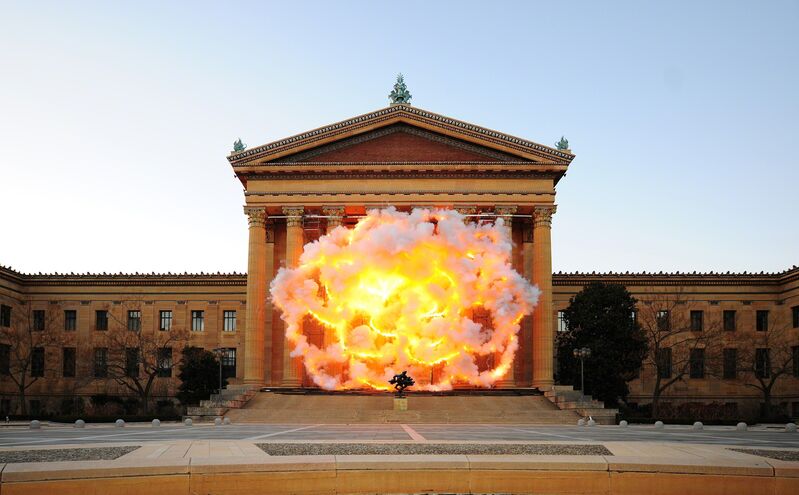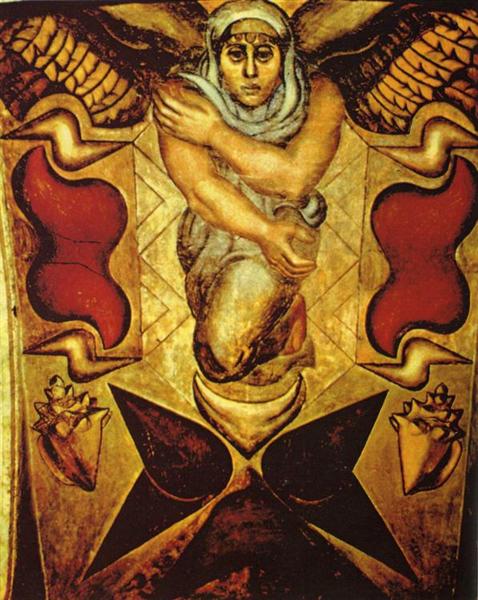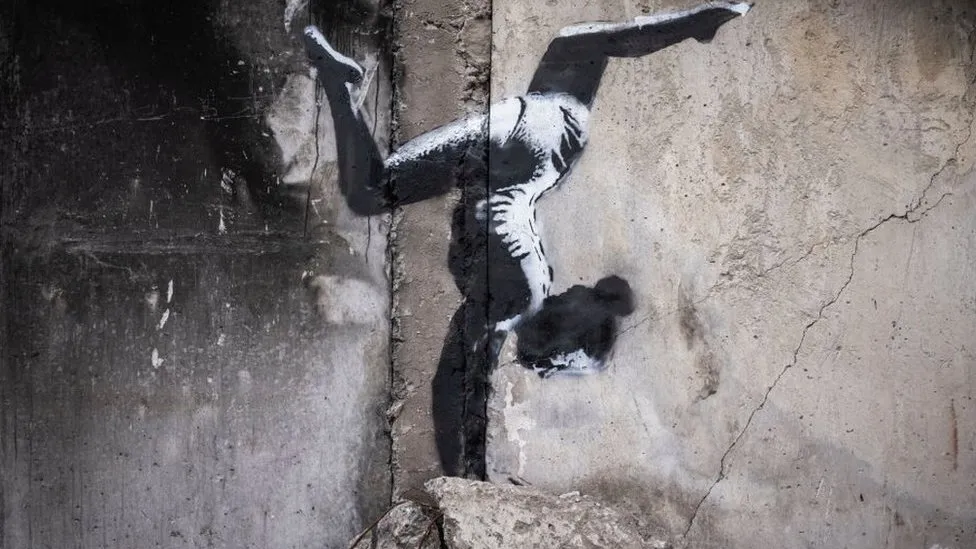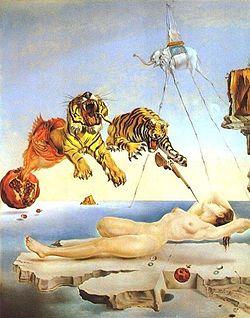The Post-Modern era takes place from 1980 to the present day. The common denominator of all forms of post-modern art is the idea that nothing holds just one intrinsic truth that everyone can see and understand because each human experience is inherently different.
Deconstruction is not only the principal guideline for postmodernism but a medium as well. With deconstruction as a guiding principle, everyone is free to come to their own conclusions. Frank Gehry is a pioneering deconstruction artist who works with raw materials and architecture.
Fish Lamps by Frank Gehry (1983.) Plastic laminate.
Deconstruction most often takes the form of sculpture, Fish Lamps is no different, but with the added element of electricity. It stands out to me because it is an art that serves a practical function, but is still classified as art. Or maybe it isn’t, it depends on who you ask. The fact that it greys the line between an appliance, and a sculpture embodies the very principle of deconstruction. It isn’t following a set of rules that determines what is art and what isn’t, it isn’t claiming to be anything specific and leaves that interpretation up to the individual beholder. Gehry has done several installations of plastic laminate glued onto wires in the shape of fish and then illuminated from the inside out. Personally, I love this piece and I would definitely have it in my home. I think that the fact that it functions as a light makes it all the more captivating and interesting to look at. They can be hung from the ceiling or mounted flush to a wall; thus making the experience completely different depending on how they're displayed.
Frank Gehry is also an award-winning architect and has designed dozens of visually striking buildings. The use of architecture as an art form is nothing new, but its execution has evolved with technology throughout the centuries, making architectural art more commonplace than it has ever been previously in history.
Dancing House by Frank Gehry (1992-96.)
Dancing House is located in the Czech Republic and is used as an office building. The site on which it was built is actually a historic site, the location of a home that was destroyed in the U.S. bombing of Prague in 1945. The non-traditional design was controversial at the time of its completion because its “new baroque” style stands out amongst the Gothic buildings that surround it. The building appears to be distorted, almost like it’s been pinched on its left side. At the very top of the building is a large pile of twisted medals that has been nicknamed “The Medusa.” The building appears to be almost animated or something out of Harry Potter because of the cartoony appearance of the windows but is contrasted by the sleek, modern look of the glass that sheaths the left-most collum of the building. I can’t tell if I love this building or hate it. I think that it's a little dizzying to look at because of all the different artistic directions that it’s going in, but that’s also what makes it interesting. I think that I’d have to agree with the controversy that surrounded it; it does stand out from the Gothic and neo-classical style buildings that surround it and I think that the placement itself just itches my brain in the wrong way. However, I do love its name: Dancing House. It has a nice ring to it.
Another art form that postmodernism took is installation art. Installation art is a display that is generally designed for a specific space and is often there for a limited period of time and is meant for public consumption.
 Fallen Blossom: Explosion Project by Cai Guo-Qiang (2009.) Gunpowder fuse, metal net for gunpowder fuse, scaffolding.
Fallen Blossom: Explosion Project by Cai Guo-Qiang (2009.) Gunpowder fuse, metal net for gunpowder fuse, scaffolding.
Cai Guo-Qiang is an installation artist who uses gunpowder and controlled explosions to paint on canvas. His methods are unconventional, to say the least, and his art installations are fun and exciting to behold. His medium bleeds into performance art because of its theatrical nature, as well as deconstruction because of his unconventional use of materials. His work can be classified as fitting closely into either of these subcategories, depending on the piece.
The explosion forms the pattern of a blossom, thus the name. This piece could also be considered deconstruction art because it utilized several elements in ways that were not intended. In doing so, Guo-Qian has redefined their purpose and defined conventionality which is the defining act of post-modern art.
Another installation artist is Tadashi Kawamata. His art is site-specific in the sense that his installations are meant to stand apart from the space that its in and encourage onlookers to re-think their surroundings. If you saw one of Kawamata’s works while walking down the street, it’d probably stop you in your tracks.
Grandmaison by Tadashi Kawamata (2008.)
Grandmaison is a massive collection of wooden pallets piled up into a wave that's pouring off of the top of the building and onto the street. Kawamatas works often grow over time, and leave room for growth still after their completion. Visually, there is no shortage of material in a finite amount of space. This is his commentary on environmentalism and human’s relationship with expansion and the environment. As chaotic as it looks, it is still methodical and delicately balanced. It forces the onlooker to focus on the overwhelming presence of otherwise overlooked objects.
The post-modern era has ushered in a boom in street art, public sculptures, public murals, and graffiti. Street art is considered any form of public art, usually in urban/metropolitan areas. It takes the form of many different mediums and varies in permanence. One street artist, Julian Beever, uses chalk to create optical illusions of great depth on city streets. Because chalk fades so quickly, the only record of his work is via photographs. The technological sophistication of the modern day makes it possible to keep a record of these works as well as generate profit for an otherwise unprofitable medium of art such as chalk.
That Hemmed In Feeling by Julian Beever.
What’s so striking about Beever’s work is the intricate amount of detail. I like that they have the potential to be interactive, as well as just visually interesting. Also, when viewed from afar or from any angle other than dead on, the picture is indistinguishable. He uses the element of perspective very intentionally. Additionally, the three-dimensional aspect of his pieces is only visible when viewed from a photo; whether it be an iPhone, professional camera, or polaroid picture, the three-dimensional element of these pieces is not visible to the naked eye.
Unlike street art, graffiti art is less often welcomed and in some cases, is punishable by legal action. I find graffiti art fascinating because graffiti has always existed! There have been ancient graffiti discovered by archeologists in many ancient ruins and on many ancient artifacts. They’ve even discovered graffiti in the ruins of Pompeii.
Untitled by Banksy. November 2022.
Because of the taboo nature of graffiti, most graffiti artists are anonymous, but there are some distinguished few. One of them is a person that goes by ‘Banksy.’ They’re a kind of celebrity in the art world, although their identity is unknown to the public. He’s famous for stenciling graffiti in public spaces, most often walls, and usually containing some allusion toward moral or political commentary. I think that in creating art in solitude with the citizens of Ukraine, Banksy embodies the nonconforming nature of graffiti (and in turn, post-modernism) very well.
Works Cited
“Cai Guo-Qiang 蔡国强: Fallen Blossoms: Explosion Project (2009).” Artsy, https://www.artsy.net/artwork/cai-guo-qiang-cai-guo-qiang-fallen-blossoms-explosion-project.
“The Dancing House.” Architectural, https://architectuul.com/architecture/the-dancing-house#:~:text=The%20%22Dancing%20House%22%20is%20set,when%20the%20area%20was%20cleared.











